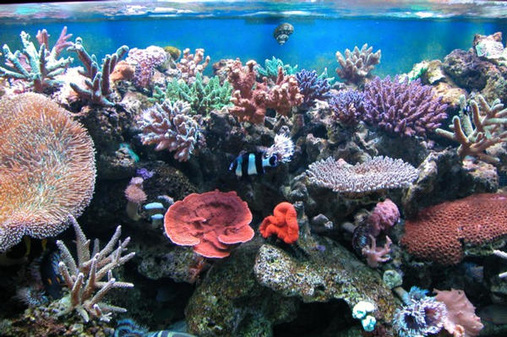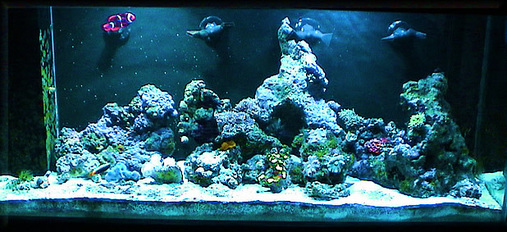SALTWATER AND REEF TANK CYCLING

Updated
Tips on cycling your fishtank.
Before you add live fish to your tank, you will need to cycle it for a period of time to create a good environment for your fish life. The term “cycling” refers to the nitrogen cycle which is the process through which beneficial bacteria in your tank work to break down wastes, converting toxic substances like ammonia and nitrite into less harmful nitrates.
In order to cycle your tank you should begin by turning on all the equipment and let it run constantly for a few days. If mixing the sea salt in a freshwater tank, follow the procedure on the package for mixing but make sure that the filter is turned on while mixing. When completed, fill the filter with the saltwater. Turn on the rest of the equipment and run the tank constantly for a few days.
Cycling with Live Rock
Cycling a saltwater tank that contains live rock is a little different from cycling one without live rock. When you cycle a tank that contains live rock, some of the organisms living in the live rock will die off in a process that produces a large amount of waste materials which can be harmful for fish. During this cycling period the ammonia level in the tank rapidly climbs as bacteria begin to process the dead organisms. This high level of ammonia, which is toxic to fish and plant life, can have a synergistic effect and cause more organisms to die. This, in turn, produces more ammonia. The populations of bacteria involved in converting ammonia to nitrite quickly build up to sufficient numbers and process the waste generated while the ammonia levels go down to undetectable levels.

You can buy live rock cycled, partially cycled or almost straight from the reef. If the live rock is going to be used in an existing reef aquarium, then cycled live rock should be used. This will minimize the peak in ammonia and nitrite caused by the addition of the rock to the tank. If you purchase live rock that has not already been cycled, or “cured”, then it is up to you to cure it before adding it to the tank. This is not a difficult process, but it will take a little time – you will learn how to cycle live rock in the next section.
75 gallons reef tank (mostly live coral and fish)

State: California
Country: United States
MORE INFO
Photo Caption:
My new reef tank!
Fish Kept:
Kaudern's Cardinal, Ocellaris Clownfish, Tank Bred (, White spotted pigmy filefish, Royal Gramma Basslet
Corals/Plants:
Mainly LPS and softies. Just started putting in corals a few months ago. My last tank was a mixed reef with a focus on sps... I think softies are one of my favorites right now though.
Tank Size:
75 gallons
How Do You Cycle Live Rock?
Start by putting the live rock into the tank or have another tank specifically for cycling purposes. Make sure that you have a skimmer in the system as well. The use of the skimmer and activated carbon removes compounds before they can break down from the bacteria. Add circulation to the water to allow good nutrient and waste exchange, but no lighting at this point. Leave this setup in place for about 2-4 weeks while monitoring the ammonia and nitrite levels. The length of the cycle takes around 2-4 weeks, from the time the rock is placed in the vessel to when the nitrite levels drop to undetectable levels.

It is also important to operate the lights during the cycling period. Operate them by increasing the length of time used during the cycling period. Start at around 6 hours per day, then increase by an hour every couple of days until a full day’s length is reached. In addition to the lighting used, activated carbon should be used in the tank filter and regular water changes should be implemented.
Here is a simple process to follow for cycling with live rock in a tank that doesn’t already contain fish, corals, invertebrates, or other creatures.
- Remove any white, slimy areas and anything else that is decaying on the rock. Removal will help to minimize the stress on the tank.
- Inspect each rock for the presence of bristle worms and remove any if found – it is also a good idea to remove any plant growth such as algae.
- Arrange the live rock in the aquarium. Ensure that only small areas are in contact with the bottom of the aquarium and between rocks - this will ensure good water circulation.
- Position return and circulation pumps so that there is good water movement throughout the entire tank - a mechanical filter can be used to help remove suspended solids from the system, but make sure that it is cleaned regularly, every day is preferred.
- Operate the skimmer continuously and keep activated carbon in a high flow area so that the water passes through it. Once the cycle is over, you can use activated carbon intermittently or continuously if you want to.
- Operate the lighting starting with a 6-hour period. Gradually increase this by an hour every couple of days until about 12-14 hours is reached.
- If white spots appear on the rock or something appears to be dying then siphon or remove it from the rock - change the water regularly and siphon out any debris that has settled.
- Start a regular maintenance program at the length and volume for a normal operating system. This varies, but around 5-10% of the system volume per month is currently recommended.

If your saltwater or reef tank is already set up and you just want to add some live rock to it, the process for curing the live rock is a little different. Follow the steps below to cure live rock before adding it to an existing tank:
- Place the new live rock in a large plastic garbage can and fill it with fresh saltwater – it should have a specific gravity between 1.021 and 1.025.
- Install an aquarium heater to maintain a water temperature in the garbage can around 80°F.
- Add an air stone or filter to ensure constant water movement in the garbage can while the live rock is being cured.
- Keep the lighting in the garbage can low and perform complete water changes (100% of the water) twice a week.
- Carefully scrub the rock with a toothbrush or bristle brush in between water changes to get rid of dead materials and white film.
- Test the water chemistry every few days – when the ammonia and nitrite levels return to zero and the water conditions in the garbage can are stable, your live rock has cured and it is ready to add to your tank.
Cycling a saltwater or reef tank is very different from cycling a freshwater tank, especially if you plan to use live rock in your tank. Before adding fish to your tank you should cycle the tank properly using the live rock. If, however, you already have a tank setup, you need to cure new live rock outside the tank before adding it.
comments powered by Disqus
































































































